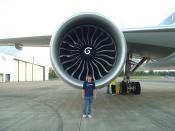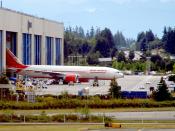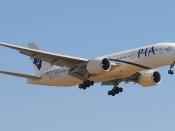boeing 777 Value Chain Analysis
Examining the value creating potential of primary activities of Boeing 777
1) Inbound operation
a) Materials
New, lightweight, cost-effective structural materials are used in several 777 applications. (Referred to Appendix 1)
Beginning in early 1994, The Boeing Company initiated a process improvement activity called Define and Control Airplane Configuration/Manufacturing Resource Management (DCAC/MRM). This "breakthrough" initiative will improve the processes the company uses to produce airplanes, and is a significant opportunity to further reduce costs, cycle time and defects. DCAC/MRM will substantially enhance the company's ability to deliver more value to its customers.
Define and Control Airplane Configuration refers to that part of the initiative that will simplify and improve internal processes for handling airplane configuration data. Specifically, these are the processes by which Commercial Airplanes generates the data that defines a customer's requested configuration for an airplane -- for example, the type of seats, galleys, lavatories, carpet, avionics, engines -- and uses that data to turn a "basic" airplane into one that has the customer's particular configuration.
Manufacturing Resource Management is the part of the initiative that will simplify and improve the manufacturing processes that are driven by the airplane configuration data.
b) Wing Design- Aerodynamic Efficiency
The 777 wing is the most aerodynamically efficient airfoil ever developed for subsonic commercial aviation. In a further refinement of designs introduced on the Boeing 757 and 767, the 777 wing features a long span with increased thickness. This advanced wing enhances the airplane's ability to achieve higher cruise speeds, climb quickly and cruise at higher altitudes than competing airplanes. It also allows the airplane to carry full passenger payloads out of many high-elevation, high-temperature airfields. Fuel volume requirements for the 777 are accommodated entirely within the wing and its structural center section. Fuel capacity ranges from 31,000...


